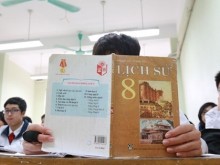Kindergarten youngsters in Hanoi are about to return to highschool immediately
Hanoi is the one locality that also permits preschool youngsters to remain at dwelling. Presently, the query
The Finnish schooling system is likely one of the finest on the planet and so they use radical concepts (extra so than Britain and America) to realize this standing. Let’s check out 27 information and statistics to see why Finnish schooling is so coveted by youngsters.
1. Finnish youngsters go to high school later than in lots of nations. Youngsters begin faculty on the age of seven, and Finns consider that “beginning faculty earlier than they’re able to develop naturally has no scientifically confirmed long-term advantages”.
2. Earlier than the age of seven, Finnish youngsters can go to kindergarten. However there, youngsters don’t study letters or math however concentrate on inventive video games. “They want time for play and bodily exercise. It is time for creativity,” mentioned Tiina Marjoniemi, head of the Franzenia nursery heart in Helsinki.
3. Each 45 minutes of examine, college students have a 15-minute break.
4. Obligatory schooling lasts solely 9 years, which suggests college students can depart faculty on the age of 16. Every part after that will likely be as much as them to decide on. The purpose of this concept is to organize Finnish college students for the true world.
5. Within the first 6 years of examine, there will likely be no examination or grading.
6. Finnish college students solely must take the focus examination when they’re 16 years outdated.
7. Finnish college students have the least variety of hours of examine per week within the developed world however nonetheless obtain one of the best leads to the long term. The college day begins at 8-9am and ends at 2pm.
8. Finnish faculties are usually not ranked in any manner, with no comparability between faculties, areas, lecturers and even college students. They consider that cooperation is the important thing to success, not competitors.
9. Finnish lecturers are among the many most certified on the planet. To change into a instructor right here, it’s important to meet very excessive requirements. Solely about 10% of the candidates are profitable and so they all have grasp’s levels.
10. In society, Finnish lecturers have the identical standing as docs and legal professionals.
11. Finnish lecturers are usually not given marks, maybe as a result of their entrance choice is so strict. Because of this, they really feel no have to continually consider and grade their lecturers. If a instructor is unsatisfactory, it’s the principal’s duty to take action.
12. Faculties are usually not inspected. Faculty inspection in Finland was abolished within the early Nineteen Nineties. They consider within the professionalism of lecturers and college leaders.
13. There is no such thing as a selective faculty, no non-public faculty. One of many causes there isn’t a competitors between faculties in Finland is that they’re all funded by way of public funds. No competitors will degree the enjoying area.
14. All Finnish college students obtain free faculty meals. Since 1943, the nation’s college students have loved a scorching, wholesome lunch throughout their 9 years of education.
15. Finnish college students have entry to particular person help relying on their wants from the second they enter faculty. They consider that each little one has particular wants, so particular schooling is for everybody.
16. The fundamentals are precedence. As a substitute of specializing in enhancing grades, dominating in math, science and English, the Finnish schooling system focuses on making a wholesome and harmonious atmosphere by which college students study. They argue that schooling needs to be “a software to stability social inequality”.
17. Finnish college students don’t change lecturers for as much as 6 years of education. This is likely one of the pillars of the harmonious academic atmosphere ideology. It creates a better relationship between college students and lecturers, which will increase the extent of belief and respect for one another as a substitute of regularly altering lecturers.
18. Finnish college students have much less homework than wherever else on the planet. Though they examine much less, they nonetheless full all the required work whereas in school. This may assist your little one change into a contented and accountable grownup.
19. All courses in Finland are combined, non-selective.
20. Finnish college students study extra languages. Once they first go to high school, they study their mom tongue. On the age of 9, youngsters started to study Swedish, the second language of Finland. By the age of 11, youngsters study a 3rd language (normally English). Many college students even begin studying a fourth language once they flip 13. Youngsters will likely be examined for his or her first two languages in a closing examination on the finish of highschool.
21. Lecturers normally solely spend 4 hours a day within the classroom and have 2 hours per week for skilled improvement, so they’re additionally much less harassed.
22. The Finnish Nationwide Curriculum is a broad-based information. This permits lecturers to make use of their very own types and concepts at school. It may be seen that the schooling system on this nation locations quite a lot of belief in lecturers.
23. In Finland, 93% of scholars graduate from highschool, greater than within the US.
24. Thereafter, 24 66% of highschool college students proceed to additional examine (school, college or vocational coaching).
25. Finland spends about 30% much less per pupil than the US, UK, Japan and Germany, in accordance with OECD statistics.
26. Virtually 100% of ninth graders in Finland go on to highschool. This determine consists of most kids with extreme disabilities.
27. About 43% of scholars aged 16 and over attend vocational faculties.
(In keeping with educationcorner)
>See extra: Fortunate Thai boy wasn’t caught in a cave as a result of… he hadn’t completed his homework






